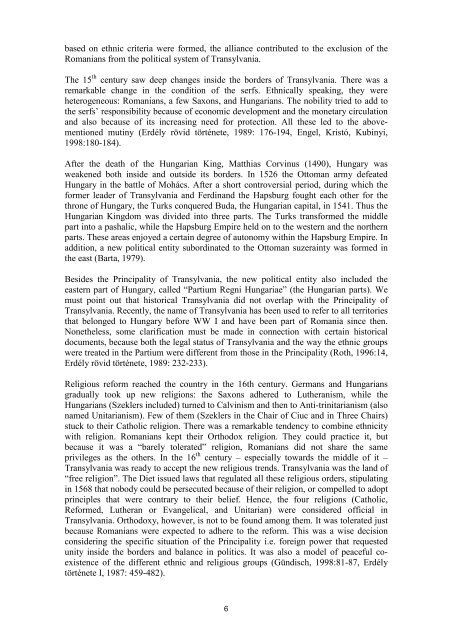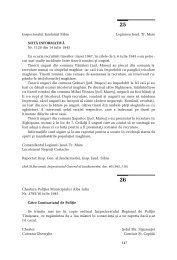Southeast Europe
Southeast Europe
Southeast Europe
Create successful ePaper yourself
Turn your PDF publications into a flip-book with our unique Google optimized e-Paper software.
ased on ethnic criteria were formed, the alliance contributed to the exclusion of the<br />
Romanians from the political system of Transylvania.<br />
The 15 th century saw deep changes inside the borders of Transylvania. There was a<br />
remarkable change in the condition of the serfs. Ethnically speaking, they were<br />
heterogeneous: Romanians, a few Saxons, and Hungarians. The nobility tried to add to<br />
the serfs’ responsibility because of economic development and the monetary circulation<br />
and also because of its increasing need for protection. All these led to the abovementioned<br />
mutiny (Erdély rövid története, 1989: 176-194, Engel, Kristó, Kubinyi,<br />
1998:180-184).<br />
After the death of the Hungarian King, Matthias Corvinus (1490), Hungary was<br />
weakened both inside and outside its borders. In 1526 the Ottoman army defeated<br />
Hungary in the battle of Mohács. After a short controversial period, during which the<br />
former leader of Transylvania and Ferdinand the Hapsburg fought each other for the<br />
throne of Hungary, the Turks conquered Buda, the Hungarian capital, in 1541. Thus the<br />
Hungarian Kingdom was divided into three parts. The Turks transformed the middle<br />
part into a pashalic, while the Hapsburg Empire held on to the western and the northern<br />
parts. These areas enjoyed a certain degree of autonomy within the Hapsburg Empire. In<br />
addition, a new political entity subordinated to the Ottoman suzerainty was formed in<br />
the east (Barta, 1979).<br />
Besides the Principality of Transylvania, the new political entity also included the<br />
eastern part of Hungary, called “Partium Regni Hungariae” (the Hungarian parts). We<br />
must point out that historical Transylvania did not overlap with the Principality of<br />
Transylvania. Recently, the name of Transylvania has been used to refer to all territories<br />
that belonged to Hungary before WW I and have been part of Romania since then.<br />
Nonetheless, some clarification must be made in connection with certain historical<br />
documents, because both the legal status of Transylvania and the way the ethnic groups<br />
were treated in the Partium were different from those in the Principality (Roth, 1996:14,<br />
Erdély rövid története, 1989: 232-233).<br />
Religious reform reached the country in the 16th century. Germans and Hungarians<br />
gradually took up new religions: the Saxons adhered to Lutheranism, while the<br />
Hungarians (Szeklers included) turned to Calvinism and then to Anti-trinitarianism (also<br />
named Unitarianism). Few of them (Szeklers in the Chair of Ciuc and in Three Chairs)<br />
stuck to their Catholic religion. There was a remarkable tendency to combine ethnicity<br />
with religion. Romanians kept their Orthodox religion. They could practice it, but<br />
because it was a “barely tolerated” religion, Romanians did not share the same<br />
privileges as the others. In the 16 th century – especially towards the middle of it –<br />
Transylvania was ready to accept the new religious trends. Transylvania was the land of<br />
“free religion”. The Diet issued laws that regulated all these religious orders, stipulating<br />
in 1568 that nobody could be persecuted because of their religion, or compelled to adopt<br />
principles that were contrary to their belief. Hence, the four religions (Catholic,<br />
Reformed, Lutheran or Evangelical, and Unitarian) were considered official in<br />
Transylvania. Orthodoxy, however, is not to be found among them. It was tolerated just<br />
because Romanians were expected to adhere to the reform. This was a wise decision<br />
considering the specific situation of the Principality i.e. foreign power that requested<br />
unity inside the borders and balance in politics. It was also a model of peaceful coexistence<br />
of the different ethnic and religious groups (Gündisch, 1998:81-87, Erdély<br />
története I, 1987: 459-482).<br />
6









